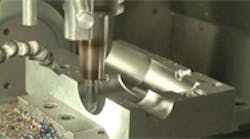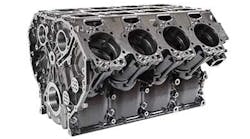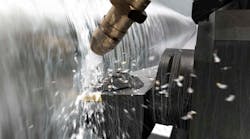Modern milling machines operate with high spindle speeds, and most shops realize that balancing toolholders becomes increasingly important as spindle speeds increase.
An unbalance causes centrifugal forces that increase at a rate squared to the spindle speed. So, at 10,000 rpm the unbalance in a toolholder causes a centrifugal force that is 25 times higher than the same unbalance at 2,000 rpm.
The centrifugal force stresses the spindle bearings and reduces their life.
Consequently, the spindle bearings become damaged, and unnecessary repair costs are incurred. That is the reason that manufacturers of milling machines and spindles specify the use of balanced tools.
Often, if unbalanced tools are used, there will be no warranty on the machine spindle.
The direction of the centrifugal force that results from unbalance changes as it rotates with the spindle causing vibrations, and vibrations shorten the life of the cutting tools. That results in high cutting-tool costs and a decrease in surface finish quality.
Although there is a greater benefit to balancing holders when running at high spindle speeds, there is always a benefit to having balanced toolholders, even at low spindle speeds.
Most shops have experienced the situation in which the speed that cutting tools can be run is limited because of the sound that the machine tool makes with increased speeds, or because the cutting tool life decreases dramatically with increased speeds.
More often than not, those limits on spindle speed are due to an unbalance within the toolholder assembly. However, by balancing the toolholder assembly, speeds and feeds can be increased resulting in decreased cycle time.
Pre-balancing may not be good enough
Purchasing pre-balanced toolholders is generally a good idea because it provides the best headstart in the balancing process.
The majority of the unbalance inherent in the design of the toolholder can be removed in the pre-balance state.
However, cutting tools often are unsymmetrical, with side lock shanks or flats on the shank, for example, that add unbalance to the assembly.
Many toolholders have movable parts that can have different positions after being mounted, such as pull studs, clamping screws, bearing races, collets and locknuts.
Most toolholder manufacturers stock product in a pre-balanced condition. This means the toolholders are fully balanced without components such as cutting tools, pull studs, collets, clamping nuts, moveable bearings or data chips. Then, fine balancing is done with a balancing machine with the toolholder fully assembled as it will run in the machining center.
Usually, lower-speed applications may require fine balancing once the assembly is complete.
This is because the cutting tool has a unique geometry, such as special form tools or boring heads, or, if the toolholders are CAT50, they may need to be re-balanced after installation of the pull stud. However, there are times when fine balancing of the toolholder assembly is not necessary, and so it is a big advantage to start with a prebalanced toolholder.
The only way to confirm that the assembly is balanced is by having a balancing machine in the shop.
Often, shops need to do little correction of assemblies if they use properly pre-balanced shrinkfit chucks, the option for balance repeatability, or small-diameter, round-shanked cutting tools that have an equal number of cutting edges. Typically, with such tools, shops only have to confirm that they are balanced.
Remember, it takes very little to destroy a spindle that is poorly balanced assembly and running too fast.
Toolholders for high speed machining always should be balanced when mounted as a complete setup that includes the cutting tool and other components.
Once toolholder elements have been modified, the balance level changes.
Balance all toolholders
It is important to be sure that all the toolholders in a shop are balanced because just a single process with an unbalanced tool at high spindle speed can damage the spindle bearings.
Because it is nearly impossible to avoid mixing up balanced and unbalanced toolholders, both newly acquired toolholders and those in inventory should be balanced.
When a shop receives a shipment from a vendor, it should check that the balance level of pre-balanced toolholders is correct. Checking the balance of toolholders always should be a part of the quality control for incoming goods, particularly if a shop is paying a premium for finebalanced tools.
Tips on choosing a balancing machine
Simple balancing systems often aren’t handled correctly because the operators don’t know the physical background of unbalance and balancing.
Sometimes the existing unbalance can be increased instead of reduced because balancing machines are not adjusted correctly for the specific tool.
Most shops can’t afford to have a specialist on staff just for balancing. However, this is not necessary.
Operators can be intimidated because they feel that balancing is complicated.
However, with a good machine, balancing is simple.
The operator only has to choose the type of tool that is to be balanced, and the machine should guide them through the procedure. The machine has the expert knowledge and not the operator.
As an investment, a balancing machine must be efficient to be justified.
The purchasing price has only a small influence on the efficiency of the investment.
A balancing machine is efficient, when:
- Process reliability in the production is improved.
- Life of the spindle is extended. A single replacement of a spindle often costs more than a balancing machine.
- Frequency of machine downtime is decreased. The most expensive factor in a production process is when a machine is not cutting.
- Machined part quality and surface finish are improved.
- Maximum spindle speeds and feeds can be used for greater throughput.
- Tool life is extended.
- And cutting capacity is improved.
Overall, the most important factor is that a balancing machine is easy to handle and provides accurate, repeatable results.
This article is based on information from HaimerUSA, LLC (www.haimer-usa.com).







